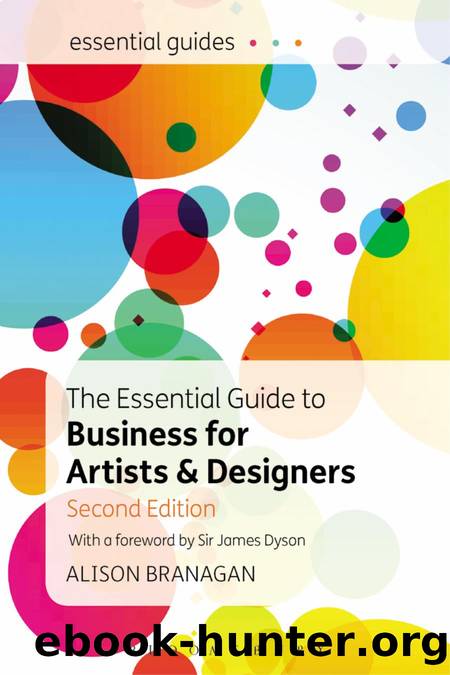The Essential Guide to Business for Artists and Designers by Alison Branagan;

Author:Alison Branagan;
Language: eng
Format: epub
ISBN: 9781474250573
Publisher: Bloomsbury UK
Published: 2019-11-28T00:00:00+00:00
Stealing ideas
You simply must not take images, lyrics or designs from the web or from books â even with a number of alterations such as colour changes, removing parts, distortion, etc. â and then claim them as your own creative product. Itâs important to gain permission from the creator or to pay a licensing fee, otherwise you could risk litigation. Unfortunately, artists and designers often only realise how damaging this activity is when it happens to them.
What to do if you have been ripped off
Do not communicate with the individual or business who you think may have copied your artwork, designs or products and passed them off as their own. Instead, quickly gather all your evidence of research and creation, sketchbooks, photographs of work in progress, catalogues, digital files and samples, together with a copy of the offending image (screenshot or print) or object (an actual purchase), and go straight to an IP lawyer to seek advice. Any delay can be fatal to your claim.
It can get messy if you try to be your own lawyer; I really wouldnât recommend taking on businesses who are âpassing offâ your products or artworks as their own unless you are fully conversant with the law. However, it is possible to represent yourself and have your case heard in an Intellectual Property Enterprise Court. Equally, a local IP lawyer and the IPO itself via the gov.uk website can offer guidance.
However, if a business or individual is just using your images on their website without your permission, as mentioned earlier photographers can now take legal action. A Google image search is a good way to start tracking down websites that are using your images. You can upload an image that you are trying to check, or locate the use of the same image elsewhere if already on Google images.
If you are a photographer, illustrator, artist or designer and you see your images being used by a blogger, for instance, just to make their page look more appealing, then you could phone or email the owner of the blog or website and politely remind them in a friendly way that they may have âforgottenâ or âoverlookedâ securing a licence from you to use the image concerned, and what a fair usage fee would be.
Equally, in another scenario the blogger might actually be using the image to endorse you and encourage people to commission or purchase your artwork or designs. Nowadays most creatives welcome this and may overlook any illegitimate use of an image in this circumstance. It is really about how they have used the images, how influential they are and whether they have a significant following.
Some artists and designers have taken to news and social media to vent their fury and expose infringers or copyists. This is a high-risk strategy, but if you search on Google for âTatty Devine vs Claireâs Accessoriesâ or âYou Thought We Wouldnât Noticeâ you will find some examples of victorious campaigns. Itâs best to seek advice from an IP lawyer when venturing down this route, especially when emotions are running high.
Download
This site does not store any files on its server. We only index and link to content provided by other sites. Please contact the content providers to delete copyright contents if any and email us, we'll remove relevant links or contents immediately.
Shoot Sexy by Ryan Armbrust(17637)
Portrait Mastery in Black & White: Learn the Signature Style of a Legendary Photographer by Tim Kelly(16933)
Adobe Camera Raw For Digital Photographers Only by Rob Sheppard(16881)
Photographically Speaking: A Deeper Look at Creating Stronger Images (Eva Spring's Library) by David duChemin(16599)
Bombshells: Glamour Girls of a Lifetime by Sullivan Steve(13952)
Art Nude Photography Explained: How to Photograph and Understand Great Art Nude Images by Simon Walden(12954)
Perfect Rhythm by Jae(5305)
Pillow Thoughts by Courtney Peppernell(4188)
The Book of Joy by Dalai Lama(3882)
Good by S. Walden(3468)
The Pixar Touch by David A. Price(3344)
A Dictionary of Sociology by Unknown(2998)
Fantastic Beasts: The Crimes of Grindelwald by J. K. Rowling(2975)
Humans of New York by Brandon Stanton(2814)
Stacked Decks by The Rotenberg Collection(2796)
Read This If You Want to Take Great Photographs by Carroll Henry(2653)
On Photography by Susan Sontag(2562)
Insomniac City by Bill Hayes(2478)
Photographic Guide to the Birds of Indonesia by Strange Morten;(2476)
